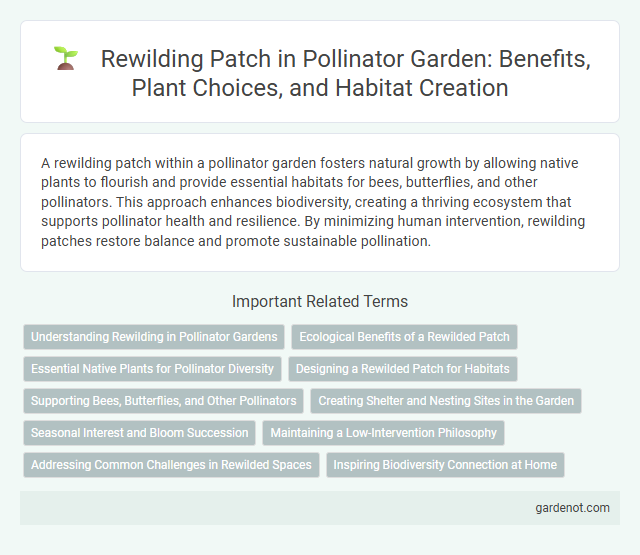A rewilding patch within a pollinator garden fosters natural growth by allowing native plants to flourish and provide essential habitats for bees, butterflies, and other pollinators. This approach enhances biodiversity, creating a thriving ecosystem that supports pollinator health and resilience. By minimizing human intervention, rewilding patches restore balance and promote sustainable pollination.
Understanding Rewilding in Pollinator Gardens
Rewilding in pollinator gardens involves restoring native plant species and natural habitats to support diverse pollinator populations, including bees, butterflies, and hummingbirds. This approach enhances ecosystem health by increasing floral diversity and providing continuous forage and nesting resources. Emphasizing native flora and minimizing human intervention helps create self-sustaining environments that promote pollinator resilience and biodiversity.
Ecological Benefits of a Rewilded Patch
A rewilded patch in a pollinator garden enhances biodiversity by providing native plants that support diverse insect populations, including essential pollinators like bees and butterflies. The ecological benefits include improved soil health through natural nutrient cycling and increased habitat connectivity, which supports local wildlife resilience. This natural habitat restoration also aids in carbon sequestration and water regulation, contributing to broader environmental sustainability.
Essential Native Plants for Pollinator Diversity
Essential native plants such as milkweed, goldenrod, and black-eyed Susan play a crucial role in rewilding patches by supporting diverse pollinator species including bees, butterflies, and hummingbirds. These plants provide nectar, pollen, and habitat, fostering ecological balance and enhancing pollination efficiency. Prioritizing native flora in pollinator gardens optimizes biodiversity and resilience within local ecosystems.
Designing a Rewilded Patch for Habitats
Designing a rewilded patch for habitats involves selecting native plants that support local pollinators such as bees, butterflies, and hummingbirds, enhancing biodiversity and ecosystem resilience. Incorporating structural diversity with layers of shrubs, wildflowers, and grasses creates microhabitats essential for nesting and foraging. Strategically avoiding pesticide use and integrating water sources further enrich the habitat, promoting sustainable pollinator populations.
Supporting Bees, Butterflies, and Other Pollinators
The rewilding patch is designed to create a thriving habitat that supports bees, butterflies, and other pollinators by providing native flowering plants rich in nectar and pollen throughout the growing season. This diverse ecosystem enhances biodiversity, improves pollination rates essential for food production, and offers shelter and breeding areas for various pollinator species. Integrating rewilded areas within pollinator gardens boosts ecosystem resilience and promotes the conservation of declining pollinator populations.
Creating Shelter and Nesting Sites in the Garden
Creating shelter and nesting sites in a pollinator garden enhances biodiversity by providing safe habitats for bees, butterflies, and other pollinators. Incorporating native woody shrubs, dense grasses, and stacked logs offers essential refuge and breeding grounds. These natural structures support species survival and promote a thriving ecosystem within the rewilding patch.
Seasonal Interest and Bloom Succession
A rewilding patch in a pollinator garden enhances seasonal interest by offering a continuous succession of blooms from spring through fall, ensuring a reliable nectar source for bees, butterflies, and other pollinators. Native wildflowers such as Echinacea, goldenrod, and asters bloom at staggered intervals, promoting biodiversity and habitat stability. This diverse planting strategy supports pollinator health year-round and contributes to the resilience of local ecosystems.
Maintaining a Low-Intervention Philosophy
Maintaining a low-intervention philosophy in a rewilding patch supports natural ecosystem processes and enhances biodiversity by allowing native plants and pollinators to thrive with minimal human interference. This approach fosters habitat resilience, promoting pollinator health and population stability essential for effective pollination services. Strategic monitoring ensures invasive species are controlled without disrupting the balance of native flora and fauna.
Addressing Common Challenges in Rewilded Spaces
Rewilding patches in pollinator gardens effectively address common challenges such as habitat fragmentation, invasive species, and limited food sources by restoring native plant diversity and structural complexity. Introducing a variety of native flowering plants supports pollinator diversity and resilience while enhancing ecosystem services like pollination and soil health. Ongoing management practices, including controlled disturbances and monitoring, ensure long-term stability and successful rewilding outcomes.
Inspiring Biodiversity Connection at Home
Creating a rewilding patch in your pollinator garden enhances local biodiversity by providing native plants that attract essential pollinators such as bees, butterflies, and hummingbirds. Incorporating a variety of flowering species ensures a continuous food source throughout the seasons, supporting a thriving ecosystem. This approach fosters a deeper connection to nature, encouraging sustainable gardening practices and wildlife conservation right at home.
Rewilding patch Infographic

 gardenot.com
gardenot.com